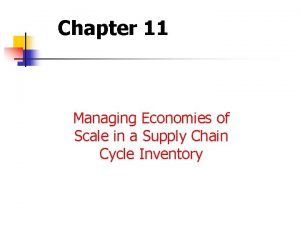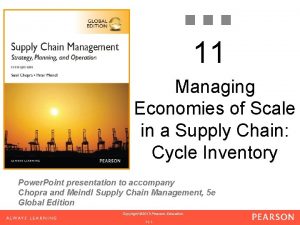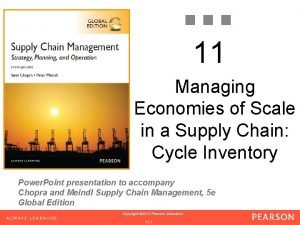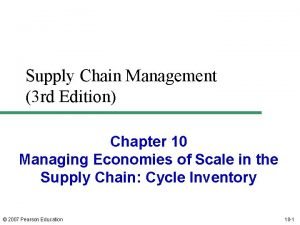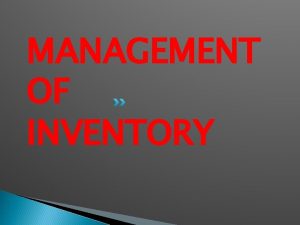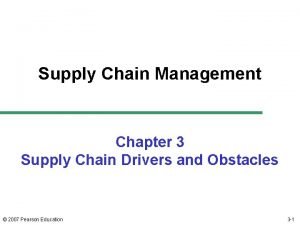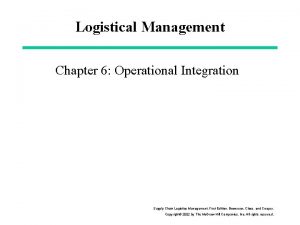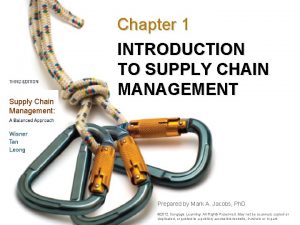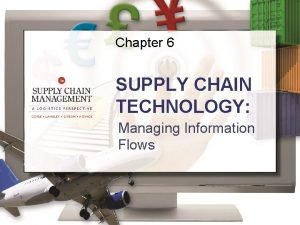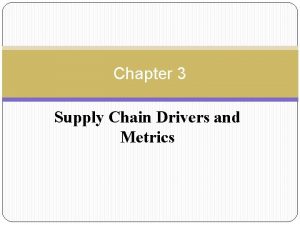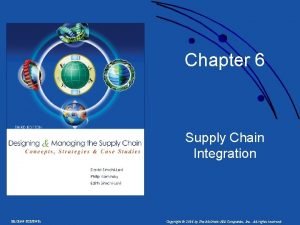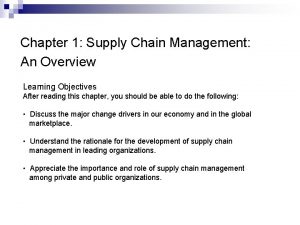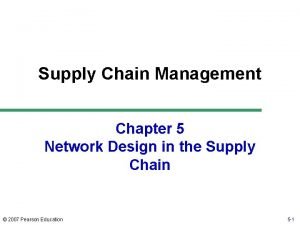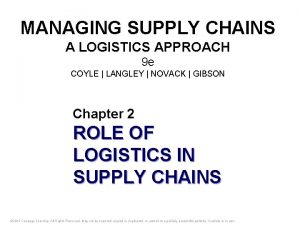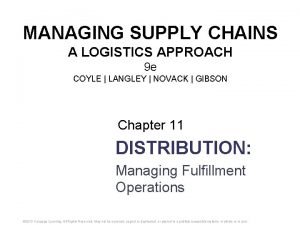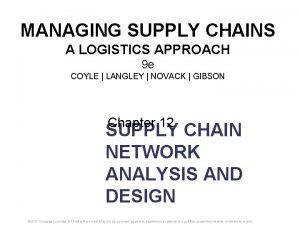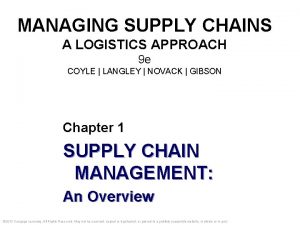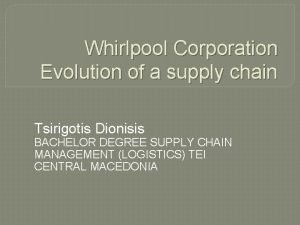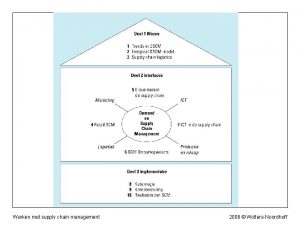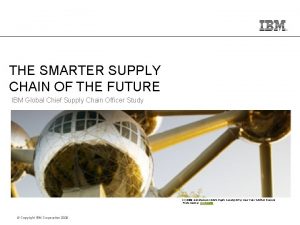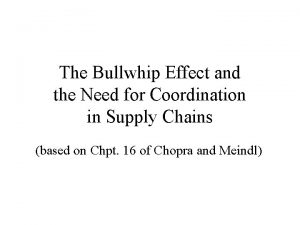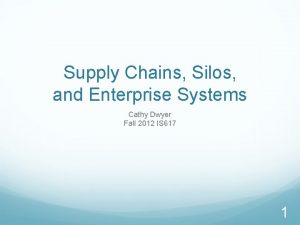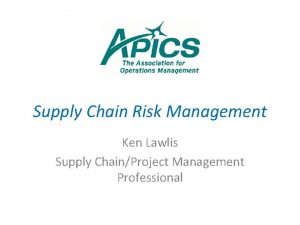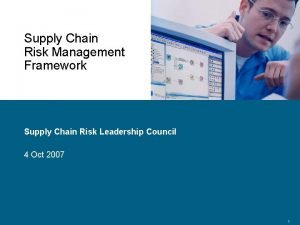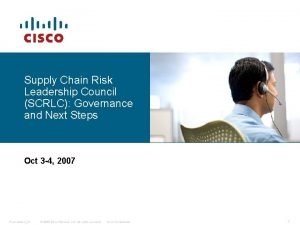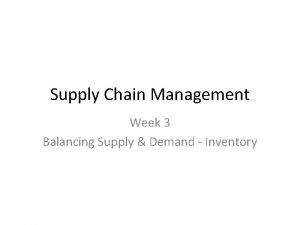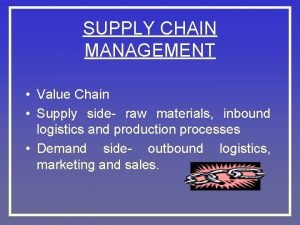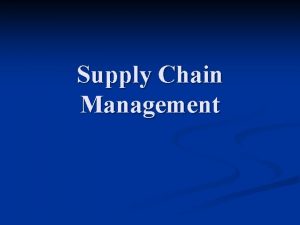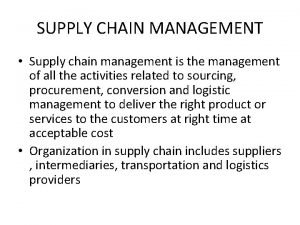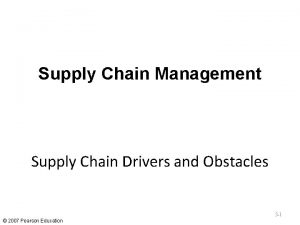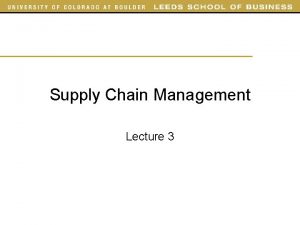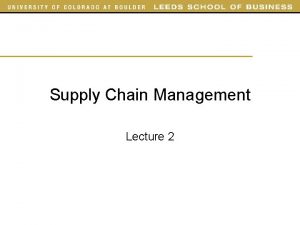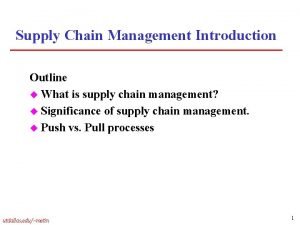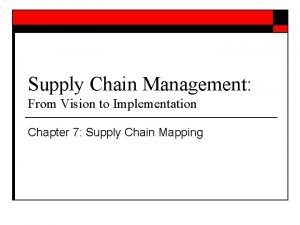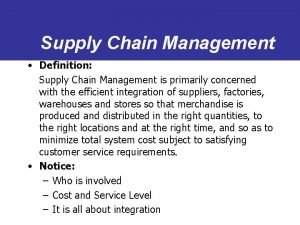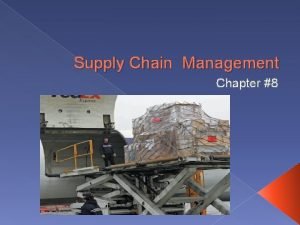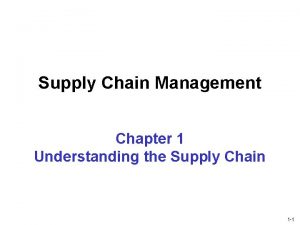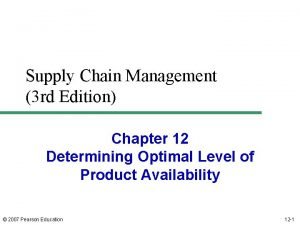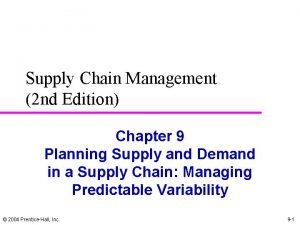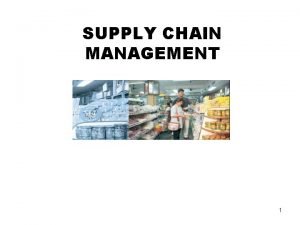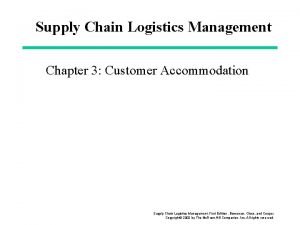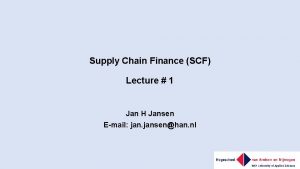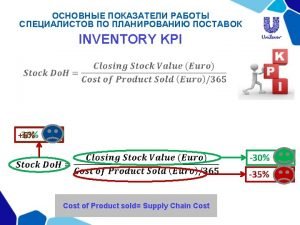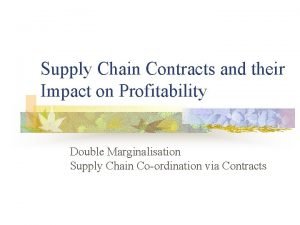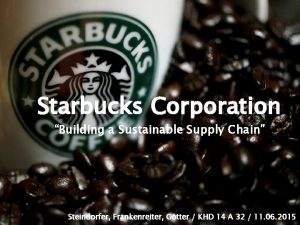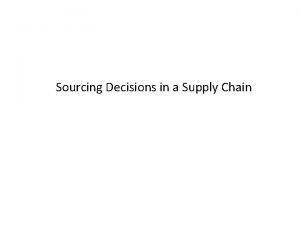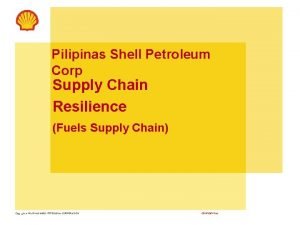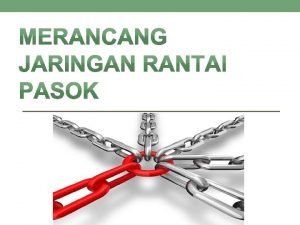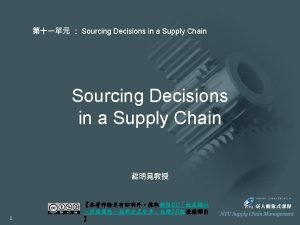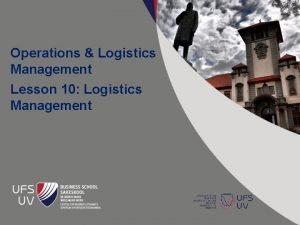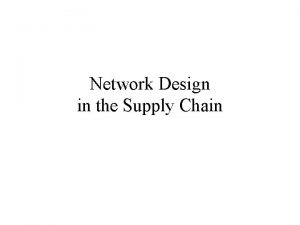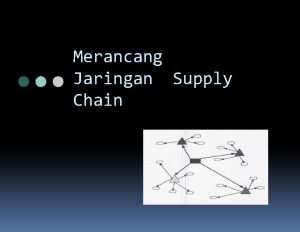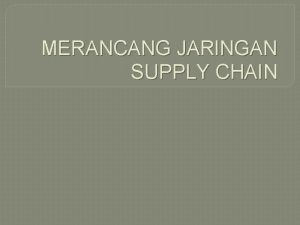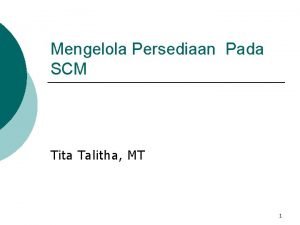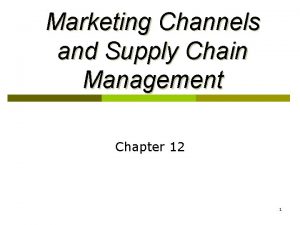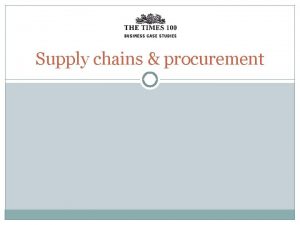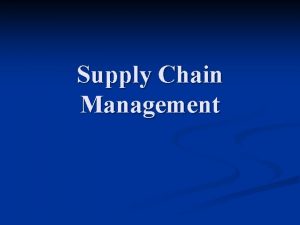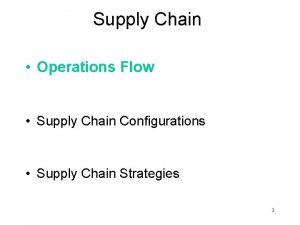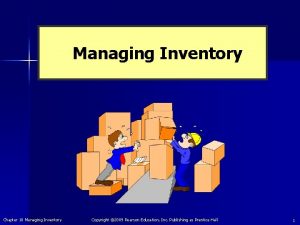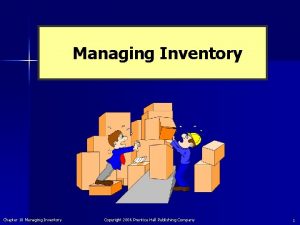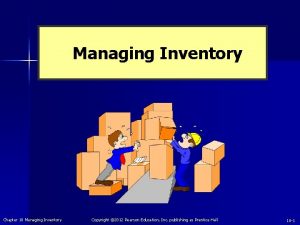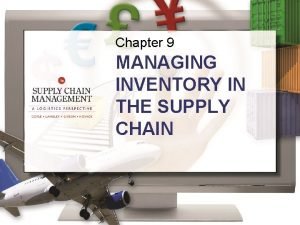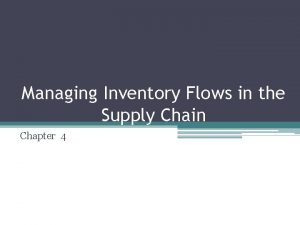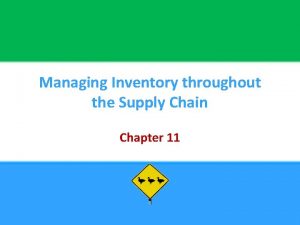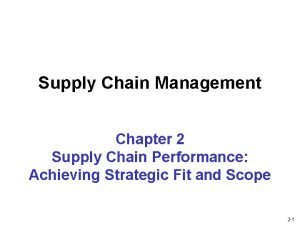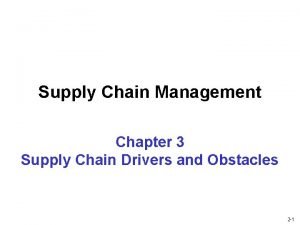Chapter 9 Managing Inventory in the Supply Chain







































































- Slides: 71

Chapter 9 Managing Inventory in the Supply Chain Learning Objectives After reading this chapter, you should be able to do the following: ¨ ¨ ¨ Appreciate the role and importance of inventory in the economy. List the major reasons for carrying inventory. Discuss the major types of inventory, their costs, and their relationships to inventory decisions. Understand the fundamental differences among approaches to managing inventory. Describe the rationale and logic behind the economic order quantity (EOQ) approach to inventory decision making, and be able to solve some problems of a simple nature.

Learning Objectives (cont. ) After reading this chapter, you should be able to do the following: Understand alternative approaches to managing inventory—justin-time (JIT), materials requirement planning (MRP), distribution requirements planning (DRP), and vendor-managed inventory (VMI). ¨ Explain how inventory items can be classified. ¨ Know how inventory will vary as the number of stocking points changes. ¨ Make needed adjustments to the basic EOQ approach to respond to several special types of applications. ¨

Introduction ¨ Inventory is an asset on the balance sheet and a variable expense on the income statement. ¨ Inventories also have an impact on return on investment (ROI) for the firm. ¨ Inventories also have an impact on return on investment (ROI) for an organization.


GDP versus Inventory ¨ Nominal GDP grew by 127. 2 percent between 1990 and 2006. ¨ The value of inventory increased by 78. 4 percent during the same time period. ¨ Inventory costs as a percent of GDP declined from 17. 9 percent in 1990 to 14. 1 percent in 2006. ¨ The absolute value of inventory increased during this time period, but it decreased as a percentage of GDP.


Batching economies or cycle stocks ¨ arises from three sources n procurement n production n transportation Scale economies are often associated with all three, which can result in the accumulation of inventory that will not be used or sold immediately

Uncertainty/Safety Stocks ¨ All organizations are faced with uncertainty. ¨ On the demand side, there is usually uncertainty in how much customers will buy and when they will buy it. ¨ On the supply side, there might be uncertainty about obtaining what is needed from suppliers and how long it will take for the fulfillment of the order.

Time/In-Transit and Work-in-Process Stocks ¨ The time associated with transportation means that even while goods are in motion, an inventory cost is associated with the time period. The longer the time, the higher the cost. ¨ WIP inventories, associated with manufacturing, can be significant while the length of time the inventory sits in a manufacturing facility waiting and should be carefully evaluated in relationship to scheduling techniques and the actual manufacturing/assembly technology.




Seasonal Stocks Seasonality can occur in the supply of raw materials, in the demand for finished product, or in both. ¨ Those faced with seasonality issues are constantly challenged when determining how much inventory to accumulate. ¨ Seasonality can impact transportation. ¨ Anticipatory Stocks ¨ A fifth reason to hold inventory arises when an organization anticipates that an unusual event might occur that will negatively impact its source of supply.

n The Importance of Inventory in Other Functional Areas ¨ Logistics interfaces with an organization’s other functional areas n Finance n Marketing n Manufacturing

Inventory Costs ¨ Inventory Carrying Costs n Capital Cost (interest or opportunity cost) ¨ cost of capital tied up in inventory and the resulting lost opportunity from investing that capital elsewhere ¨ hurdle rate ¨ weighted average cost of capital (WACC).

Storage Space Cost includes handling costs associated with moving products into and out of inventory, as well as such costs as rent, heat, and light ¨ Can be variable ¨ Inventory Service Cost ¨ includes insurance and taxes Inventory Risk Cost ¨ reflects the possibility that inventory value might decline for reasons beyond firm’s control

Calculating the Cost of Carrying Inventory ¨ Calculating the cost to carry (or hold) a particular item in inventory involves three steps. n First, determine the value of the item stored in inventory. n Second, determine the cost of each individual carrying cost component to determine the total direct costs consumed by the item while being held in inventory. n Third, divide the total costs calculated in Step 2 by the value of the item determined in Step 1.




Nature of Carrying Cost ¨ Ordering Cost or Setup Cost n refers to the expense of placing an order for additional inventory, not including product cost ¨ Order n Cost of placing order which may have both fixed and variable components ¨ Setup n Costs expenses incurred each time an organization modifies a production or assembly line to produce a different item for inventory



n Expected Stockout Cost ¨ several consequences might occur: n Back order, which results in the vendor incurring incremental variable costs associated with processing and making the extra shipment n Customer might decide to purchase a competitor’s product resulting in a direct loss for the supplier. n Customer might decide to permanently switch to a competitor’s product with loss of income.

Safety Stock n Cost calculation Formula

In-Transit Inventory Carrying Cost ¨ Owner of product while it is in transit will incur resulting carrying costs. ¨ In-transit inventory carrying cost becomes especially important on global moves since both distance and time from the shipping location both increase. ¨ Owner should consider its delivery time part of its inventory carrying cost.


n Determining the Cost of In-Transit Inventories ¨ The capital cost of carrying inventory in transit generally equals carrying inventory ¨ storage space cost not relevant to inventory in transit ¨ insurance needs requires special analysis ¨ obsolescence or deterioration costs are lesser risks for inventory in transit


Dependent versus Independent Demand ¨ “independent” when such demand is unrelated to the demand for other items ¨ “dependent” when it is directly related, or derives from, the demand for another inventory item or product Pull versus Push ¨ The “pull” approach relies on customer orders to move product through a logistics system, while the “push” approach uses inventory replenishment techniques in anticipation of demand to move products.

Principle Approaches -Techniques for Inventory Management ¨ Fixed order quantity model involves ordering a fixed amount of product each time reordering takes place ¨ Simple EOQ Model n The following are the basic assumptions of the simple EOQ model: ¨ ¨ ¨ ¨ 1. A continuous, constant, and known rate of demand 2. A constant and known replenishment or lead time 3. All demand is satisfied 4. A constant price or cost that is independent of the order quantity (i. e. , no quantity discounts) 5. No inventory in transit 6. One item of inventory or no interaction between items 7. Infinite planning horizon 8. Unlimited capital





n The EOQ model can be developed in standard mathematical form, using the following variables:


Determining Q can be accomplished by differentiating the TAC function with respect to Q, as shown in Formula 9 -5









Total cost model formulas:



n The Just-in-Time Approach ¨ Four major elements n zero inventories n short, consistent lead times n small, frequent replenishment quantities n high quality, or zero defects


Materials Requirements Planning: ¨ deals specifically with supplying materials and component parts whose demand depends on the demand for a specific end product ¨ consists of a set of logically related procedures, decision rules, and records designed to translate a master production schedule into time-phased net inventory requirements and the planned coverage of such requirements for each component item needed to implement this plan


MRP system uses the following elements: ¨ Master production schedule (MPS) ¨ Bill of materials file (BOM) ¨ Inventory status file (ISF) ¨ MRP program ¨ Outputs and reports




Distribution Requirements Planning: Purpose is to more accurately forecast demand to explode that information back to develop production schedules. ¨ Firm can minimize inbound inventory in conjunction with production schedules. ¨ Outbound (finished goods) inventory is minimized ¨ DRP develops a projection for each SKU requiring the following: ¨ n n n Forecast of demand for each SKU Current inventory level of the SKU (balance on hand, BOH) Target safety stock Recommended replenishment quantity Lead time for replenishment



Vendor-Managed Inventory ¨ The basic principles: n n n The supplier and its customer agree on which products are to be managed using in the customer’s distribution centers. An agreement is made on reorder points and economic order quantities for each of these products. As these products are shipped from the customer’s distribution center, the customer notifies the supplier, by SKU, of the volumes shipped on a real-time basis. ¨ This notification is also called “pull” data


ABC Analysis: ¨ ¨ Assigns inventory items to one of three groups according to the relative impact or value of the items n A items are considered to be the most important n B items being of lesser importance n C items being the least important Pareto’s Law, or the “ 80– 20 Rule” n many situations were dominated by a relatively few vital elements




Inventory at Multiple Locations—The Square-Root Rule: The square-root rule states that total safety stock inventories in a future number of facilities can be approximated by multiplying the total amount of inventory in existing facilities by the square root of the number of future facilities divided by the number of existing facilities.


Summary n Inventory as a percent of overall business activity continues to decline. Explanatory factors include greater expertise in managing inventory, innovations in information technology, greater competitiveness in markets for transportation services, and emphasis on reducing cost through the elimination of non-value-adding activities. n As product lines proliferate and the number of SKUs increases, the cost of carrying inventory becomes a significant expense of doing business. n There a number of principle reasons for carrying inventories. Types of inventory include cycle stock, work-in-process, inventory in transit, safety stock, seasonal stock, and anticipatory stock. n Principle types of inventory cost are inventory carrying cost, order/setup cost, expected stockout cost, and in-transit inventory carrying cost. n Inventory carrying cost is composed of capital cost, storage space cost, inventory service cost, and inventory risk cost. There are precise methods to calculate each of these costs. n Choosing the appropriate inventory model or technique should include an analysis of key differences that affect the inventory decision. These differences are determined by the following questions: (1) Is the demand for the item independent or dependent? (2) Is the distribution system based upon a push or pull approach? (3) Do the inventory decisions apply to one facility or to multiple facilities?

Summary (cont. ) n Traditionally, inventory managers focused on two important questions to improve efficiency, namely, how much to reorder from suppliers and when to reorder. n The two aforementioned questions were frequently answered using the EOQ model, trading inventory carrying cost against ordering costs, and then calculating a reorder point based on demand or usage rates. n The two basic forms of the EOQ model are the fixed quantity model and the fixed interval model. The former is the most widely used. Essentially, the relevant costs are analyzed (traded off), and an optimum quantity is decided. This reorder quantity will remain fixed unless costs change, but the intervals between orders will vary depending on demand. n The basic EOQ model can be varied or adapted to focus more specifically on decisions that are impacted by inventory-related costs, such as shipment quantities where price discounts are involved. n Just-in-time inventory management captured the attention of many U. S. organizations during the 1970 s, especially the automobile industry. As the name implies, the basic goal is to minimize inventory levels with an emphasis on frequent deliveries of smaller quantities and alliances with suppliers or customers. To be most effective, JIT should also include quality management

Summary (cont. ) n Materials requirements planning and distribution requirements planning are typically used in conjunction with each other. In addition, a master production schedule is utilized to help balance demand supply of inventory. DRP is used on the outbound side of a logistics system. Demand forecasts of individual SKUs are developed to drive the DRP model. Then, an MPS schedule is developed to meet the scheduled demand replenishment requirements. n VMI is used to manage an organization’s inventories in its customers’ distribution centers. Using pull data, suppliers monitor inventory levels and create orders to ship product to bring inventory levels up to an economic order quantity in the customers distribution centers. n ABC analysis is a useful tool to improve the effectiveness of inventory management. Another useful tool is the quadrant model. n When organizations are adding warehouses to their logistics networks, a frequently asked question is, “How much additional inventory will be required? ” The square root rule is a technique that can be used to help answer this question.
 The required safety inventory
The required safety inventory A key to reducing lot size without increasing costs is to
A key to reducing lot size without increasing costs is to Managing economies of scale in a supply chain
Managing economies of scale in a supply chain Managing economies of scale in a supply chain
Managing economies of scale in a supply chain Marginal unit quantity discount
Marginal unit quantity discount Matching supply and demand in supply chain
Matching supply and demand in supply chain Difference between logistics and supply chain
Difference between logistics and supply chain Sequence of food chain
Sequence of food chain Chapter 5 section 1 supply and the law of supply
Chapter 5 section 1 supply and the law of supply Inventry meaning
Inventry meaning Chapter 3 supply chain drivers and metrics
Chapter 3 supply chain drivers and metrics Operational integration in logistics
Operational integration in logistics Chapter 1 supply chain management
Chapter 1 supply chain management Chapter 6 supply chain management
Chapter 6 supply chain management Drivers and metrics in supply chain
Drivers and metrics in supply chain Dell supply chain case study
Dell supply chain case study Chapter 1 supply chain management
Chapter 1 supply chain management Network design in the supply chain chapter 5
Network design in the supply chain chapter 5 Managing supply chains a logistics approach
Managing supply chains a logistics approach Managing supply chains: a logistics approach
Managing supply chains: a logistics approach Managing supply chains a logistics approach
Managing supply chains a logistics approach Managing supply chains a logistics approach
Managing supply chains a logistics approach Pagbabago sa dami ng supply at pagbabago sa supply
Pagbabago sa dami ng supply at pagbabago sa supply Whirlpool corporation evolution of a supply chain
Whirlpool corporation evolution of a supply chain Werken met supply chain management
Werken met supply chain management Supply chain lci
Supply chain lci Supply chain management and total quality management ppt
Supply chain management and total quality management ppt Ibm supply chain strategy
Ibm supply chain strategy Pipeline in supply chain
Pipeline in supply chain Incentive obstacles
Incentive obstacles Silos in supply chain
Silos in supply chain Supply chain risk register
Supply chain risk register Supply chain risk management framework
Supply chain risk management framework Supply chain risk management framework
Supply chain risk management framework Cisco supply chain risk management
Cisco supply chain risk management Supply chain leadership council
Supply chain leadership council Maq corporation case study solution
Maq corporation case study solution 4 flows of supply chain
4 flows of supply chain Supply in line sequence
Supply in line sequence Supply chain it framework
Supply chain it framework Framework for structuring drivers
Framework for structuring drivers Netflix supply chain
Netflix supply chain Collaborative supply chain
Collaborative supply chain Replenishment cycle in supply chain
Replenishment cycle in supply chain Pipeline in supply chain
Pipeline in supply chain Supply chain management meaning and definition
Supply chain management meaning and definition Supply chain upstream and downstream
Supply chain upstream and downstream Pull supply chain
Pull supply chain Tailored sourcing supply chain
Tailored sourcing supply chain Predictable variability is
Predictable variability is Supply chain upstream and downstream
Supply chain upstream and downstream Customer accommodation
Customer accommodation Polyself.xyz paradigm
Polyself.xyz paradigm Scc supply chain
Scc supply chain Buy back contract supply chain example
Buy back contract supply chain example Starbucks supply chain diagram
Starbucks supply chain diagram Tailored sourcing
Tailored sourcing Python supply chain optimization
Python supply chain optimization Hyperledger sawtooth supply chain
Hyperledger sawtooth supply chain Pharmaceutical supply chain initiative psci
Pharmaceutical supply chain initiative psci Shell
Shell Konfigurasi jaringan supply chain
Konfigurasi jaringan supply chain Role of sourcing in supply chain
Role of sourcing in supply chain Supply chain organization chart
Supply chain organization chart Introduction to operations and supply chain management
Introduction to operations and supply chain management Supply chain network design decisions
Supply chain network design decisions Contoh model konfigurasi supply chain
Contoh model konfigurasi supply chain Contoh konfigurasi supply chain
Contoh konfigurasi supply chain Mengelola persediaan pada supply chain
Mengelola persediaan pada supply chain Vertical marketing
Vertical marketing Channel levels in marketing
Channel levels in marketing Marketing channels and supply chain management
Marketing channels and supply chain management

